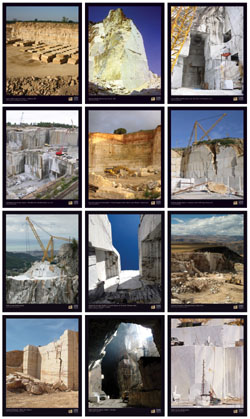“While meeting these programming goals, we wanted the mausoleum to preserve Lakewood’s pastoral quality while offering a contemplative interior experience,” said Joan Soranno, Design Principal with HGA Architects and Engineers of Minneapolis, MN. “Rather than dominating its site, the mausoleum becomes part of the landscape and context.”
Soranno explained that the mausoleum is a “contemporary architectural expression that fits within the historic context of the cemetery through massing, materials and site orientation.” It expanded crypt and cremation burials for more than 10,000 people, plus a chapel and reception space.
Selecting the stone
Natural stone was used extensively throughout the exterior and interior design of the mausoleum. The exterior features both Academy Black® and Charcoal Black® granite — supplied by Cold Spring Granite of Cold Spring, MN — with a rough-cut finish, which was used to bring character and depth to the design. Additionally, the exterior is defined by a beautiful stone mosaic pattern that adds a soft effect when paired with the textured stone. “We chose split-faced gray granite because of its tactile, textural quality. The granite lends a sense of solidity that anchors the Mausoleum to its site and contrasts with the white mosaic-tile artwork surrounding the doors and windows,” Soranno said.
The exterior white mosaic tile surrounding the main entrance on the street-facing north facade follows the traditional artistry set by the adjacent Lakewood Chapel with its intricate, colorful mosaic interiors — reinterpreted in “infinite loop patterns across white billowing surfaces.” The 18- x 18-inch mosaic panels consist of small pieces of Carrara marble and white glass in an abstract pattern. Modified versions of this pattern also frame the Committal Chapel and crypt windows along the southern facade. “The contrast between the split-faced gray granite and white mosaic tile at the main entry draws an analogy between the earthbound and the spiritual — suggesting a metaphorical crossing over,” explained Sorrano.
Cold Spring Granite was brought on the project by the contractor, M.A. Mortenson, for help with stone selection, due to their amount of stone colors, finishes, technical support, and ability to keep to tough schedules.
When she began working on this project, Soranno wasn’t entirely sold on granite. She considered slate and limestone as well. “We had a lot of different pieces in our office for about a year before we decided,” said Soranno. “We then did mockup walls of three different types of stone, and the selection of Cold Spring Granite’s material was unanimous.”
Selecting the color of the granite was probably the biggest challenge for this job. Cold Spring Granite provided multiple samples of colors and finishes until the final samples were selected. Listening to the effect Soranno wanted and drawing on the results of previous projects, Cold Spring Granite was able to supply multiple options to Soranno until a winner was found. “It was an extensive color and finish process,” said Todd Olson, Regional Sales Representative. “But, that’s why we’re here.”
“Their strongest part was in the pre-design stage,” said Soranno. “We had so many pieces of granite in our office that we could have constructed a building with it.” Cold Spring Granite was responsive to Soranno’s requests and continuously supplied different samples until the perfect combination was found.
The solution was to use a combination of two different granites, one from California and one from Minnesota. Soranno chose a combination of Academy Black and Charcoal Black granite for the rough split face veneer. Using the two shades gave the building just the right hint of sparkle. To represent the imperfection of life, Soranno preferred a coarse exterior to the structure. Cold Spring Granite helped Soranno refine the finish by going back several times and refinishing and “roughing up” the surface until the granite met the coarse appearance she desired. “We were encouraging the rougher, the better,” said Soranno.
To continue with the irregular look, the granite was installed with extensive lippage creating an imperfect look. Soranno explained that the sought-after effect produces complex shadows across the granite facades.
The area is complemented by granite benches, a pool and paved walkways in Cold Spring Granite’s Diamond Pink® granite, invoking a sense of peaceful paths and quiet resting places leading to the mausoleum. Cold Spring Granite worked in conjunction with Soranno and the landscape architect, Halverson Design Partnership, to coordinate the color and finish of the paving, pool and benches. The result is that the color of the granite adds an understated warmness to the landscape, while working in concert with the stark, serene feel of the mausoleum.
Interior stone use
Inside, White Alabama marble — in varying size pieces — adorns the walls and floors in several areas. The White Alabama marble tiles in the common spaces measure 3 x 3 feet. Meanwhile, the columbaria and crypt rooms are finished in various-sized rectangular panels of the same Alabama White marble measuring 10 x 12 inches to 3 feet, 7 inches x 7 feet, 9 inches. The marble was quarried at the Purple Mountain site in Sylacauga, AL, and processed by Santucci Group of Italy.
“We selected the marble for its beauty, its reflective surfaces, and its capacity for engraving,” said Soranno, adding that the most challenging aspect of the project came to be controlling the amount of veining on the White Alabama marble. “We didn’t want the veining to be too heavy because it would make the marble too busy.”
To bring a striking contrast to the interior design of the mausoleum, Green, Pink and Honey Onyx were employed separately as flooring in the various crypts and columbarium, with tiles measuring 18 x 18 inches in size. The onyx is bordered by Black Nero Marquina marble varying in size from 2½ inches x 2 feet to 30 x 30 inches.
The design team felt that onyx was the best choice in the crypt and columbarium for its vibrant colors and translucent quality. According to Soranno, natural stone was the only material considered for the project. “Stone was our first choice because it is compatible with Lakewood’s existing architectural vocabulary, and it’s durable and permanent,” she said. “We made weekly site visits to consult with the installers (Grazzini Brothers & Co. on the interior marble and Mortenson Construction and CD Tile on the exterior stone). The masons were highly knowledgeable and skilled, and the installation process went seamlessly. We previously worked with Mortenson on Bigelow Chapel of the United Theological Seminary of the Twin Cities, which involved similar craftsmanship, so we knew their work and attention to detail. Everyone was truly invested in this project.”
Programming for the mausoleum began in June 2008 and construction was completed by January 2012. It was later dedicated in May 2012.
“When we began researching the Mausoleum, we knew we had an obligation to create something that reflected the high standards established by Lakewood’s existing historic context,” Soranno said. “We wanted to create a place that people would find nurturing, inspiring and contemplative; a place that they would want to choose as their final resting place. The Mausoleum has been well-received since opening, with several major articles write about it. Lakewood has also reported that sales have exceeded expectation so far and visitors to the building have responded very positively.














